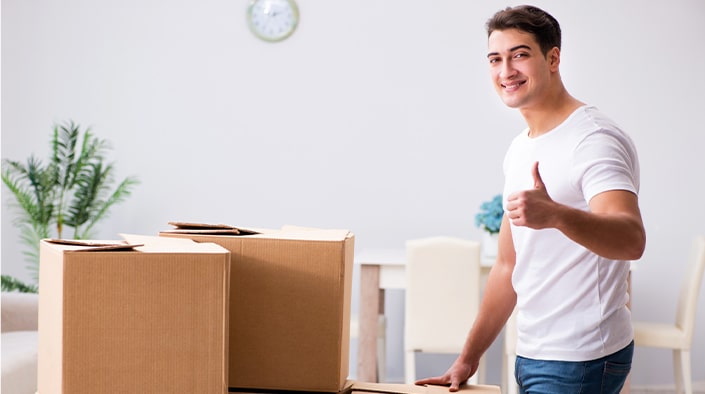Efficient Packing Tips for Your Clothing Relocation
Packing your wardrobe for a move can be daunting, especially considering the variety and volume of clothing most of us have. From delicate garments and formal wear to everyday attire and accessories, each item demands care to ensure it arrives in your new home in the best condition. Here’s a streamlined guide to help you master packing your clothes.
Start by assessing your entire wardrobe. This is an excellent opportunity to declutter and decide what to keep, donate, or discard. Once you’ve streamlined your selection, it’s time to focus on different packing techniques. Use tissue paper or cloth bags for delicate fabrics to prevent snags and tears. Hanging clothes can be transported in wardrobe boxes or specialized hanger boxes to keep them wrinkle-free.
The folding method is crucial for maximizing space and minimizing damage. Roll softer garments and fold stiffer ones to maintain their shape. Sorting clothes by season or occasion can also streamline the unpacking process at your new home.
Don’t forget about your shoes, hats, and accessories. Pack these items separately, using original boxes or protective bags to maintain their shape and condition. For shoes, stuffing them with paper can help retain their form.
By following these steps, you’ll find packing your wardrobe more organized and efficient. Remember, the key is to be methodical and careful to ensure all your clothing items make it safely to your new destination. Keep reading for more expert advice on how to pack up your belongings for a move efficiently.
Packing Clothes: What to do Beforehand
- Take inventory of your closet– Don’t just mindlessly pack your clothes for a move– give some real consideration to every article of clothing you own. It will save you time and energy down the line. Taking everything out of your closet and drawers allows you to understand better what needs to be packed instead of wasting time with less important items. Doing this helps identify which clothing is worth saving, donating or getting rid of before packing.
- Sort your clothes by type – Sorting your clothes by type will help you determine how many wardrobe boxes you will need for packing. This also helps to create less confusion once your clothing is unpacked at your new home. Separate these into piles based on the season they are most often worn in, such as heavy winter coats and lighter summer dresses.
- Determine your clothing is in condition: If you have chunky sweaters that stretch out or sensitive silk blouses with snags, it’s best to pack them up separately to prevent them from getting dirty or stretched out during the move. Get a specific packing box for these items to avoid damage or stains.
- Find the best method of packing clothes. Various ways to pack clothing include folding and rolling each item and using wardrobe boxes and plastic bags. All these methods have advantages and disadvantages, so choose the one that best suits your needs.


Pack Clothes After Folding Them Properly
- Flat Folding – The flat folding method of packing clothes is one of the best options for those who don’t have much space to pack into. This technique involves laying clothing on a flat surface, such as a bed or table, and carefully folding it over once to create a long strip. To avoid creases and wrinkles, start at the end of the folded clothing and roll it up, using the garment as the centre of each strip.
- Rolling – If you have more space to pack your clothes for moving, consider rolling them instead. This method suits those who don’t want to hassle folding or ironing everything later. Start by laying the item flat, then fold it in half to create a rectangle. Carefully roll the clothing inward, starting with the edge away from you. This method is best for items made of heavier or thicker fabrics, such as t-shirts and jeans.
- KonMari method – Another method for packing clothes is the KonMari method. Inspired by Japanese organization expert Marie Kondo, this technique involves folding each item to stand upright. You can easily see and access your clothing without occupying much space in your boxes or drawers. This method works best for lighter items and places them into packing boxes horizontally, alternating the direction of each fold to create a soft wave pattern.
- Use wardrobe boxes – One of the best ways to pack hanging clothing for moving is by using wardrobe boxes with built-in hangers. These are perfect for large items, like dresses and suits, since they provide a safe place to hang your clothing during the move. Using wardrobe boxes can help prevent damage to your clothes since they rest in a secure position at all times, preventing them from getting squashed or strained.
- Bundle hangers together – Although wardrobe boxes are ideal for most clothing items, it’s best to pack hanging items individually if you don’t have enough boxes. When using this method, wrap each piece of clothing around a hanger, then secure it with sturdy packing tape before placing it in the moving box. This will help prevent creases and other damage during transport.
Packing Clothes: Materials Needed
- Wardrobe boxes – As mentioned above, wardrobe boxes are a great option when packing clothing for a move. Not only do they keep your clothes organized, but they also allow you to pack more items than you could with traditional moving boxes. If possible, order these boxes to be ready to go when you start packing.
- Plastic bags – While they may not be the most aesthetically pleasing option, they are an excellent choice for packing sensitive or delicate clothing. This includes items like silk blouses and formal dresses. Use two layers of plastic bags for even more protection during the move, if possible.
- Cardboard boxes – Traditional moving boxes are the next best option if you don’t plan on using wardrobe boxes. When packing clothing into cardboard boxes, it’s essential to ensure that each item is folded correctly or rolled so there isn’t a chance of wrinkles or creases forming.
- Suitcases are great for packing clothes and shoes and are also very budget-friendly. If you have some lying around your house, put them to good use the next time you need to move!
- Duffel bags –Duffel bags are roomy enough to pack folded clothes and shoes, but rolling your garments before placing them in the bag is more space-efficient and will reduce wrinkles.
- Compression or Vacuum bags – If you have a lot of bulky items that you need to pack, spray or pour water into the bags before sealing them up. This will help shrink your clothes and make them easier to stack inside moving boxes.
- Tape, scissors, markers, and packing tape – You will also need some basic supplies to pack your clothes. Make sure you have plenty of packing tape and extra scissors and markers if you are labelling every box.


Sort Your Closet
- Sort according to the material – Sorting your clothes by the type of material they are made from will save you time when doing laundry in the future. For example, cotton items, silk items, denim items, linen items, wool items and cashmere items can all go into separate categories.
- Sort by Color – If you have no interest in sorting your clothes by material, try sorting them by colour. This can help when it comes time to put away your dresses after the move, as it will be much easier for you to find everything that is blue or red.
- Arrange by season – You may want to arrange your clothes by season instead. After all, you don’t need all your winter items in the middle of summer! This system works well if you’re moving from one region to another. For example, if you drive from Florida to Minnesota, it might be a good idea to bring a few warm sweaters and jackets.
How to Pack Clothes for Moving
- Consider using more than one method of packing. For example, if you have mostly hanging clothes, use a wardrobe box to keep them organized and protected during the move. If you have many knitted or bulky items, try rolling them up into tight balls, then place them inside vacuum-sealed bags to save space. You can also place valuable clothing items inside plastic wrap and then place them carefully inside a cardboard box for added protection.
- Talk to your movers about packing options that may be available for clothing. Depending on where you live, a company may provide wardrobe boxes for rent or purchase, saving you time and money when moving. Some companies also offer special services like cleaning and pressing your clothes, so check out your options.
- Invest in quality packing tape. Keep your boxes secure during the move, which will also help prevent any damage or scratches if the boxes rub against each other in transit.
- Sort by frequency of use – Another option is to sort your clothes according to how frequently you wear them. This works well for people moving from a place where it’s warm year-round and will be moving somewhere with all four seasons. If this is the case, you’ll want to bring enough clothes to last through the winter and summer without having to lug around a bunch of out-of-season garments you won’t be wearing.
- Arrange by occasion – The final option is to arrange your clothes according to the event they are worn, such as work outfits, loungewear, going out outfits, etc. This can help you choose your outfits quickly and easily each morning. And it can also help you fit all your clothes into fewer boxes.
No matter how you choose to sort through your clothes, make sure that everything is organized in a wardrobe box or garment bag and easily accessible while they are in storage. Double-wrapping clothes in garbage bags will help maintain the quality of your items until you’re ready to wear them again!



